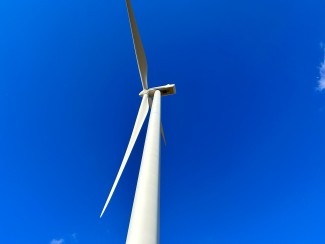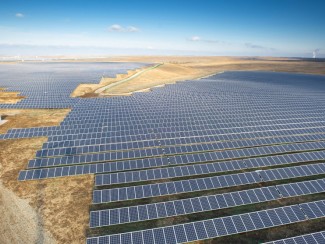Consumer and environmental advocates say the state’s lack of long-range planning requirements along with utilities’ financial incentive to “build, build, build” threaten to strand customers with obsolete infrastructure.
WEC Energy Group in southeastern Wisconsin is planning to significantly expand its capacity for natural gas electricity generation, even as it has vowed to reach net-zero carbon emissions by 2050.
In recent filings by its subsidiary WEPCO (also known as We Energies), the company has asked state utility regulators for permission to bill ratepayers for two new natural gas power plants, a liquified natural gas storage facility, and a 33-mile pipeline to supply the proposed new plants.
Altogether, the projects represent a more than $2 billion investment the utility says will be critical for balancing growing wind and solar generation but advocates say could leave customers unfairly paying for facilities that are likely to be obsolete before mid-century.
“We hope the commission will reject these proposals, and rather direct WEC to invest in cleaner technologies as well as energy efficiency,” said Ciaran Gallagher, energy and air manager for Clean Wisconsin.
WEC spokesperson Brendan Conway countered that the company is on track to meet its decarbonization goals, and that the gas plants play a role.
“The key to the renewable energy transition is to have quick start gas plants available for those times when zero carbon generation cannot meet customers energy needs,” Conway said by email. “As we transition our baseload power to renewable energy, these proposed plants will support our customers when solar and wind are not able to provide enough power. We have a number of options, including hydrogen, renewable natural gas and new technologies that will help us meet our 2050 goal. We expect these [new gas] plants will serve customers for decades.”
Demand and reliability
The first indication of the utility’s gas expansion plans came in a Feb. 1 filing in which WEC asked state regulators to let it start collecting $200 million from ratepayers now for supplies it expected to need later for constructing two new gas plants and an LNG facility.
That filing also cites WEC’s plans to convert two coal plants to burn natural gas: its Elm Road Generating Station in Oak Creek, and Unit 4 at its Weston plant near Wausau.
The company said it needs more gas capacity for three main reasons. Its coal plants are retiring, driven by Clean Air Act regulations. The regional transmission organization, MISO, is giving renewables less credit toward utilities’ capacity obligations. And demand is growing, driven largely by a boom in data centers in the area.
That means the utility needs more renewables “paired with dispatchable natural gas” and related infrastructure, the filing says. This spring, WEC proposed a 1,100 MW natural gas plant with five simple cycle combustion turbines on the site of its Oak Creek coal plant 15 miles south of Milwaukee and a 128 MW gas plant near the town of Paris in Kenosha County.
Cover letters for the Oak Creek and Paris gas plant proposals before the Public Service Commission say each project is “a key component” of WEC’s “continued transformation of its generation fleet to ensure reliability and resiliency” and comply with MISO and EPA rules.
Critics counter that gas is not the way to increase reliability, especially since natural gas supplies have been disrupted during extreme weather in the MISO region, including with winter storms Uri in 2021 and Elliott in 2022.
“There are reliability claims dotted throughout these applications,” said Gallagher. “There’s the expectation that MISO is going to devalue or lower accreditation of gas plants because they are increasingly not showing up during these winter [weather] events. Continuing to build out the dispatchable gas plants in WEC’s portfolio is leading us to a potentially more precarious position during these winter storms, as opposed to investing in wind and storage and solar.”
Until recent years, coal made up the bulk of Wisconsin’s power supply.
An 8K form filed April 15 with the Securities and Exchange Commission (SEC) notes that WEC plans to stop burning coal entirely by 2032. The form notes that 1,100 MW of coal units at Oak Creek and 300 MW at its Columbia plant will retire by 2026, and 328 MW at its Weston plant by 2032.
The Elm Road coal plant was built in 2011, at a cost of more than $2 billion plus recent spending on upgrades. Watchdogs point to its imminent conversion to gas as a warning sign about investing in fossil fuels that may soon become unviable. Ratepayers often continue paying for power plants even after they close, as much as hundreds of millions of dollars, as with We Energies’ Pleasant Prairie plant.
“In the early 2000s, the writing was on the wall that coal was bad for our health, for the climate, and there were expected carbon regulations,” said Gallagher. Yet WEC “built some of the last coal plants in the U.S., and Wisconsinites are still paying for those coal plants with their pocketbooks as well as with their health. We’re concerned that this investment in gas power plants and infrastructure is just another cash grab for WEC and their shareholders, as likely the last large gas plants are built in the United States.”
Grand gas plans
In an April 5 filing, WEC seeks approval to charge ratepayers $1.2 billion for the Oak Creek gas generators. A separate filing proposes the 128 MW Paris RICE plant at a cost of $280 million. RICE refers to the seven reciprocating internal combustion engines that would make up the plant.
The town of Paris, near the proposed plant, requested to intervene in the proceeding, noting that “while small in footprint, [the plant] may have a substantial long-term impact on the Town and its residents… The Town is already carrying a high burden of power generation for southeastern Wisconsin.”
A proposed $456.3 million liquified natural gas facility, also at the Oak Creek site, would compress and liquefy gas delivered in pipelines, storing two billion cubic feet to be ready for gas delivery interruptions and ensuring adequate supply for the new plants, WEC says.
The proposed new natural gas pipeline, known as the Rochester Lateral, would cost $186 million, WEC’s filing says.
Conway said that WEC also needs advance permission to start purchasing supplies for the gas investments.
“Due to long lead-time and high demand of some equipment, we have requested to be able to procure certain items to make sure they are available in a timely manner,” he said. Consumer advocates argue the company shouldn’t be allowed to bill ratepayers for these supplies before the new power plants are even approved.
The company meanwhile has not yet filed with the Public Service Commission for the Elm Road and Weston gas conversions. In February, the Public Service Commission approved WEC to invest $100 million to increase its share in the combined cycle gas plant West Riverside Energy Center, which it co-owns with Alliant Energy.
Financial costs, health costs
Tom Content, executive director of the state’s Citizen Utility Board, said that bill increases for the new natural gas costs would come on top of a $418 million electricity rate increase that We Energies customers are already facing in 2025 and 2026, which could add up to a nearly 30% rate hike for residential customers between 2022 and 2026, according to CUB’s analysis. Those rate increases are in part to pay for three major solar farms as well as one natural gas conversion.
In an April 12 letter to the Public Service Commission, WEC executive vice president of external affairs Robert Garvin pegged the rate increases to new wind and solar power, inflation, extreme weather, an emerald ash borer infestation that has forced tree removal near power lines, and forgiveness of low-income customer bills.
Clean energy and consumer advocates lauded the increase in renewable investments, and said WEC Energy should focus on renewables and storage rather than spending more ratepayer money on gas.
“Ultimately, our state needs a holistic approach to reducing carbon emissions and strengthening our electric infrastructure,” said RENEW Wisconsin Executive Director Sam Dunaiski. “New natural gas plants do not put us on a path toward a fully decarbonized economy. Other solutions to meet Wisconsin’s energy needs could include more distributed renewable generation, energy efficiency, performance-based rate-making, and the coupling of battery storage with solar and wind projects. Wisconsin needs transparent planning in order to make smart energy decisions for our future.”
Gallagher echoed a long-time criticism of environmental and consumer advocates: that Wisconsin does not require utilities to file regular, long-range outlooks, known as Integrated Resource Plans, like those used by regulators in many states to help guide decisions. A bill introduced last fall would create such a process in Wisconsin.
“The commission is forced into these more narrow decisions related to the need of one project or another, we’re not even seeing all four of the projects that WEC says are necessary at the same time,” Gallagher said. “There is this lack of comprehensive planning in our state, and we’re seeing the impact with these proposals.”
Content called on the commission to protect ratepayers from being saddled with costs for unnecessary power generation, including the guaranteed return on investment that utilities get as profit.
“It always comes back to the whole capital bias,” he said. “The build-build-build bias on the part of every public utility is front and center. The more they build, the more they earn.”
Health concerns
As a primary care doctor in Milwaukee, Victoria Gillet says she constantly sees patients in respiratory distress. She says she feels the pollution herself, with aching lungs when she bikes to work.
“It really impacts people’s lives,” she said. “I know for sure when the air quality gets worse, my patients end up hospitalized.”
Natural gas-fired plants emit far less particulate matter than coal-burning power plants, as well as less carbon dioxide. But gas plants emit other compounds harmful to public health, including nitrogen oxides and sulfur dioxide.
“When health is your number one focus, it has to be about just getting pollutants gone, not making them less,” Gillet said. “There is no safe number of kids having asthma attacks. The community around the Oak Creek plant fought so, so, so hard to be less impacted by the coal they’re exposed to. We shouldn’t be replacing that with something a little less worse. We should give that entire neighborhood a reprieve from being exposed to polluting industries.”
She added that her patients include “the kind, wonderful people who want to mow their neighbors’ lawns,” or do healthy outdoor exercise, but air pollution can make such activities dangerous.
“I’ve tried to be a lot more intentional, making people aware of how this will impact their health, looking at air quality indicators the same way you look at the weather,” she said. “That makes me sad.”





